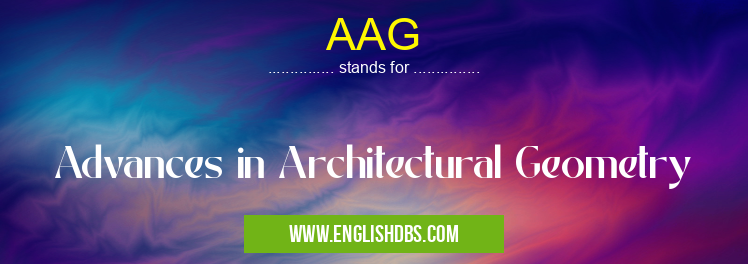What does AAG mean in ARCHITECTURE
Advances in Architectural Geometry (AAG) is an international platform for the research and practices of geometrical design in architecture, engineering and digital fabrication. The field of AAG applies both computational methods and physical means to design, engineer, fabricate, construct and study buildings or other architectural structures. It draws from disciplines such as mathematics, physics, engineering and computer-aided design (CAD), engaging numerous areas of expertise. AAG brings together researchers from different backgrounds with the aim of exploring new ideas that are able to create solutions for real life challenges.

AAG meaning in Architecture in Academic & Science
AAG mostly used in an acronym Architecture in Category Academic & Science that means Advances in Architectural Geometry
Shorthand: AAG,
Full Form: Advances in Architectural Geometry
For more information of "Advances in Architectural Geometry", see the section below.
Focus Areas
AAG focuses on research involving complex geometric forms that can be found between different disciplines: it includes studies into mathematical foundations of geometry; algorithms for optimization; form-finding; flexible geometry; structural compression; new construction techniques; visualizations; digital fabrication; materials science; machine learning techniques among others. These focus areas encompass a wide range of topics related to the development of complex geometries in architecture including swarm intelligence applications for AI-generated designs or generative design strategies based on evolutionary algorithmsand optimized support systems and structural compressions among others.
Essential Questions and Answers on Advances in Architectural Geometry in "SCIENCE»ARCHITECTURE"
What is Advances in Architectural Geometry?
Advances in Architectural Geometry (AAG) is an academic platform dedicated to the research and teaching of mathematical methods related to designing, engineering, manufacturing, constructing, and visualizing architecture. It seeks to create an international forum for discussion and knowledge sharing among architects, mathematicians, physicists and engineers.
Who is AA G designed for?
AAG is designed for architects, mathematicians, physicists and engineers interested in discussing and learning about mathematical methods related to architecture design or construction.
What topics are discussed on AA G?
Topics related to architectural geometry such as 3D modelling software, algorithmic design techniques, parametric design tools, building information modelling (BIM), simulations and visualizations are commonly discussed on AA G.
Does AA G offer any courses?
Yes, AA G offers a range of courses from undergraduate level all the way up to doctoral level. These courses cover topics within both architectural design theory as well as practical skills such as 3D modelling.
Where can I find presentations or papers published by AA G?
You can find presentations and papers from past events hosted by AAG on the AAG website or on their social media pages.
Are there any membership fees associated with being part of AA G?
No there are not any membership fees associated with being part of AAG. It operates purely through voluntary donations received from members as well as contributions made by its organizers.
How often does AA G host events?
AAG hosts several events throughout the year including workshops, lectures and conferences providing a platform for exchange of ideas amongst its members.
Why do people join AA G?
People join AAG because it provides them with an opportunity to discuss topics related to architectural geometry with other like-minded professionals from around the world as well as learn new skills related to CAD/CAM software or designing parametric models.
Does participating in AAG count towards CPD points for Architects ?
Yes participating in AAG activities can be counted towards continuing professional development (CPD) points for Architects in most jurisdictions around the globe depending on whether your local regulatory body recognizes it's contribution towards CPD points accumulation.
Final Words:
Advances in Architectural Geometry has brought many advances in our ability to design more complex forms within architecture and engineering using digital fabrication technologies like 3D printing which have revolutionized how we think about building processes. As this field continues to expand rapidly, its importance is now being recognized internationally as many universities add AAG courses into their curriculum as well as offering numerous publications dedicated solely to researching within this field.
AAG also stands for: |
|
| All stands for AAG |
